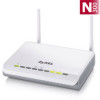ZyXEL WAP3205 User Guide - Page 133
Network Size, Notation, HOST ID SIZE
 |
View all ZyXEL WAP3205 manuals
Add to My Manuals
Save this manual to your list of manuals |
Page 133 highlights
Appendix B IP Addresses and Subnetting Subnet masks are expressed in dotted decimal notation just like IP addresses. The following examples show the binary and decimal notation for 8-bit, 16-bit, 24-bit and 29-bit subnet masks. Table 50 Subnet Masks BINARY 8-bit mask 16-bit mask 24-bit mask 29-bit mask 1ST OCTET 11111111 11111111 11111111 11111111 2ND OCTET 00000000 11111111 11111111 11111111 3RD OCTET 00000000 00000000 11111111 11111111 DECIMAL 4TH OCTET 00000000 00000000 00000000 11111000 255.0.0.0 255.255.0.0 255.255.255.0 255.255.255.248 Network Size The size of the network number determines the maximum number of possible hosts you can have on your network. The larger the number of network number bits, the smaller the number of remaining host ID bits. An IP address with host IDs of all zeros is the IP address of the network (192.168.1.0 with a 24-bit subnet mask, for example). An IP address with host IDs of all ones is the broadcast address for that network (192.168.1.255 with a 24-bit subnet mask, for example). As these two IP addresses cannot be used for individual hosts, calculate the maximum number of possible hosts in a network as follows: Table 51 Maximum Host Numbers SUBNET MASK HOST ID SIZE 8 bits 16 bits 24 bits 29 bits 255.0.0.0 255.255.0.0 255.255.255.0 255.255.255.248 24 bits 16 bits 8 bits 3 bits 224 - 2 216 - 2 28 - 2 23 - 2 MAXIMUM NUMBER OF HOSTS 16777214 65534 254 6 Notation Since the mask is always a continuous number of ones beginning from the left, followed by a continuous number of zeros for the remainder of the 32 bit mask, you can simply specify the number of ones instead of writing the value of each octet. This is usually specified by writing a "/" followed by the number of bits in the mask after the address. For example, 192.1.1.0 /25 is equivalent to saying 192.1.1.0 with subnet mask 255.255.255.128. The following table shows some possible subnet masks using both notations. Table 52 Alternative Subnet Mask Notation SUBNET MASK ALTERNATIVE LAST OCTET NOTATION (BINARY) 255.255.255.0 /24 0000 0000 255.255.255.128 /25 1000 0000 255.255.255.192 /26 1100 0000 LAST OCTET (DECIMAL) 0 128 192 WAP3205 User's Guide 133















